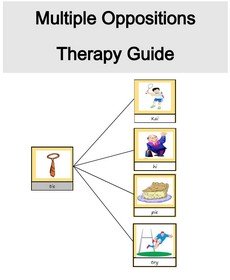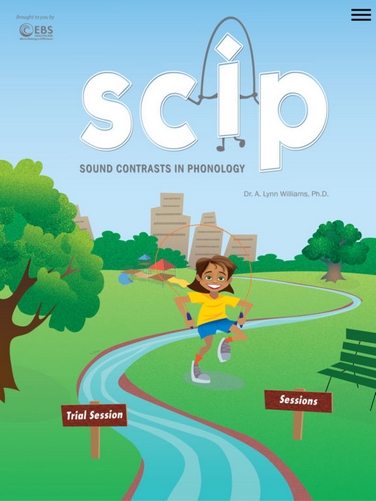Multiple Oppositions Therapy

Multiple Oppositions Therapy: In contrast to minimal pairs therapy, which focuses on contrasting paired sounds, multiple oppositions theory dictates that several speech sound errors be targeted and contrasted at the same time.
Multiple Oppositions reportedly works best with children who present with moderate to severe phonological disorder. Generally, the kids who are mostly unintelligible to unfamiliar listeners would benefit most from multiple oppositions therapy. This powerful therapy has the potential to dynamically restructure and reorganize a child's phonological system in the shortest amount of time.
Children with moderate to severe phonological disorder may substitute several or many sounds with a single phoneme. This mass substitution of consonant sounds to a single phoneme is known as a phoneme collapse.
What is a Phoneme Collapse?
A phoneme collapse is when a child uses a single consonant sound in place of other consonant sounds. The more extensive the phoneme collapse, the greater the impact on a child's overall speech intelligibility.
For example, a child may substitute /t/ for multiple consonant phonemes as he/she attempts the adult speech form. For instance, /t/ may be produced instead of /s/ /f/ /l/ and /t ʃ/. So the words sore, fore, lore and chore would all be produced by the child as tore. Note that all the initial phonemes have collapsed to /t/.
A significant phoneme collapse, where, for instance, up to 18-20 consonant sounds are substituted by a single phoneme, can have a significant impact on a child's intelligibility. It's important to note that children with severe phonological disorder may present with several phoneme collapses. A significant phoneme collapse can render a child's speech all but unintelligible.
A key component of multiple oppositions intervention is the specific selection of appropriate speech targets using a distance metric.
What is a Distance Metric?
A distance metric enables the clinician to identify and select the sounds across a rule set that have the most potential to restructure the child's phonological sound system. A key component of the distance metric is that the function of a sound is dependent on the role the sound plays in an individual's sound system. Selection of target sounds is based on a child's specific sound errors, which are unique and individual to that child. (Williams, 2006) A child's error pattern may develop as a result of the child's attempts to produce adult type speech, but, due to a limited sound system, result in a phoneme collapse.
Lynn Williams states that the distance metric contains two parameters: maximal classification and maximal distinctions. (Williams, 2005) Both parameters help the clinician select sounds for intervention based on the child's unique phoneme collapse. Specific target sounds are selected based on their maximal distinctiveness from the substituted sound in terms of place, manner, voice and linguistic unit, i.e. a single consonant /k/ or a cluster /kl/. (Williams, 2006).
Sound Target Selection for Multiple Oppositions Therapy
Sound target selection is based on the distance metric. For instance if a child collapsed the /p f l r s k sl st tr / phonemes to /t/ the therapy targets for the /t/ sound may initially be / l r k tr/. These targets would be selected because they are maximally distinct from the /t/ in terms of voice, manner, place, major class and single sound vs cluster sound. Thus the selected target sounds have the best chance to stimulate system-wide phonological restructuring in the child's sound system.
/t/ - voiceless alveolar stop - major class (obstruent)
contrasts most with selected targets ...
/l/ - voiced glide - major class (sonorant)
/r/ - voiced liquid - major class (sonorant)
/k/ - voiceless velar - major class (obstruent)
/tr/ - voiced liquid cluster - major class (sonorant/obstruent)
Multiple Oppositions Therapy
Multiple oppositions therapy targets four sounds at a time, which is in contrast to other contrastive therapy models such as minimal pairs and treatment of the empty set that target one phoneme at a time. During multiple oppositions therapy, children are confronted with several of their specific sound errors across a rule set. Children are thus exposed to four of their individual errors at a time in a way that prompts awareness of the extent of the change required.
I have created a step-by-step introductory guide to assist clinicians not familiar with multiple oppositions to begin using this method of speech intervention.
Click on the image to download the Multiple Oppositions Therapy Guide
The guide offers tips and strategies on how to make inexpensive stimulus cards for therapy and features examples of sound contrast therapy techniques and sequences. The guide is also a practical introduction on how to begin multiple oppositions therapy.
Disclaimer: The Multiple Oppositions Therapy Guide is an entry level guide and a simplified practical introduction only. The guide is based on my own experience using multiple oppositions as a therapy model for severe speech disorders.
For an in depth description of multiple oppositions intervention theory and techniques, readers are encouraged to purchase Lynn Williams' SCIP program. The SCIP program features videos, recommended contrast therapy selection for specific speech errors, intervention techniques and over 2000 pictures of contrast sounds.
Update: 08/11/2016
New SCIP program available from iTunes.
SCIP (Sound Contrasts In Phonology) is the easiest way to increase intelligibility in less time. SCIP is an evidence-based, therapeutic tool developed through a one million dollar NIH grant by ASHA Fellow Dr. A. Lynn Williams. It allows you to both create and implement treatment approaches using five different contrastive therapy approaches:
•Multiple Oppositions
•Minimal Pairs
•Maximal Oppositions
•Treatment of the Empty Set
•Vowel Contrasts
SCIP includes more than 2,350 real words and 6,000 nonsense words to provide the widest variety of treatment stimuli and support rapid progress. The app allows individual or group sessions with up to 4 students. In group sessions, each student has individualized treatment targets and data collection. Print or email graphs of treatment progress and individual session notes! Choose the option to treat word-initial or word-final sounds using pictures or illustrations. You can also print illustrations to prepare practice sets to be used away from the iPad or sent home for reinforcement. (Transcript in italics from iTunes SCIP webpage)
Click on the image to link to the iTunes SCIP webpage.
References
Bowen, C. (2009) Children's Speech Sound Disorders Wiley-Blackwell
iTunes Preview Page (2016) Text in italics and SCIP image from SCIP information page by EBS Learning
Williams, A.L. McLeod, S. & McCauley, R.J. (2010) Interventions for Speech Sound Disorders in Children Paul H Brookes Publishing Co
Williams, A.L. (2005) Assessment, Target Selection and Intervention: Dynamic Interactions Within a Systemic Perspective Topics in Language Disorders, Vol 23, No.3 pp-231-242
Williams, A.L. (2006) SCIP Sound Contrasts in Phonology: Evidence Based Treatment Program. User Manual Super Duper Publications
Williams, A.L. (2006) A Systematic Perspective for Assessment and Intervention: A Case Study Advances in Speech Language Pathology September 2006, pp 245 - 256
Updated 11/2016
Return from Multiple Oppositions Therapy to Minimal Pairs Theory


